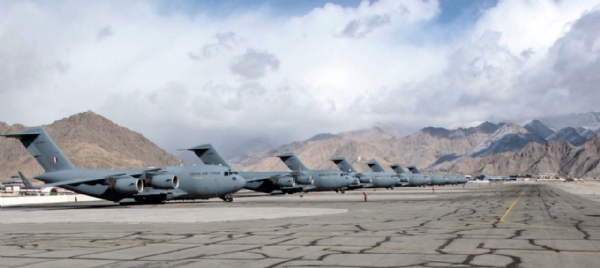IAF airlifted 68000 soldiers, tanks, fighter jets in eastern Ladakh following Galwan clashes
Total Views |
Following the deadly clashes in the Galwan Valley, the Indian Air Force airlifted 68,000 Army soldiers, around 90 tanks, and other weapon systems to eastern Ladakh for rapid deployment along the Line of Actual Control (LAC), according to top sources in the defence and security establishment. The IAF deployed its Su-30 MKI and Jaguar jets in the region for round-the-clock surveillance and intelligence gathering on the enemy buildup, in addition to deploying several squadrons of combat aircraft in "offensive posturing" in the aftermath of the clashes on June 15, 2020, which they described as the most serious military conflict between the two sides in decades.

The troops and weapons were transported by the IAF's transport fleet in a "very short period of time" for quick deployment in various inhospitable areas along the LAC as part of a special operation, according to sources, highlighting how the force's strategic airlift capability has grown over the years. In light of the rising tensions, the IAF claimed it has deployed a large number of remotely piloted aircraft (RPAs) in the region to keep a close eye on Chinese actions.
According to the Indian Army, the IAF flew numerous divisions totaling over 68,000 troops, more than 90 tanks, approximately 330 BMP infantry combat vehicles, radar systems, artillery weapons, and a variety of other equipment.
According to them, the IAF immediately improved its air defense capabilities and battle preparedness by constructing numerous radars and transporting a variety of surface-to-air guided missiles to frontline locations along the region's LAC.
According to the sources, India's general plan was to bolster military posture, retain credible forces, and watch adversary build-up to adequately respond with any circumstance. According to a source who could not provide any specifics, the IAF platforms worked in extremely challenging conditions and completed all of their mission objectives. According to another source, the total operation displayed the IAF's increased airlift capacity in comparison to what it was during "Operation Parakram."
Following the terrorist assault on Parliament in December 2001, India initiated 'Operation Parakram,' mobilizing a massive force along the Line of Control.
Following the eastern Ladakh conflict, the government has prioritized infrastructure development along the almost 3,500-kilometer-long LAC. Since the Galwan Valley conflicts, the Army has made a number of steps to improve its fighting skills.
It has already placed a considerable number of readily transportable M-777 ultra-light howitzers along the LAC in Arunachal Pradesh's hilly areas. The M-777 can be easily moved aboard Chinook helicopters, and the Army now has the ability to move them from one location to another according on operational requirements. The Army has also equipped its soldiers in Arunachal Pradesh with a large number of US-made all-terrain vehicles, Israeli 7.62MM Negev Light Machine Guns, and other dangerous weaponry. Even though the two sides completed disengagement from various regions following prolonged diplomatic and military discussions, Indian and Chinese forces are still involved in a three-year conflict in specific friction locations in eastern Ladakh.


